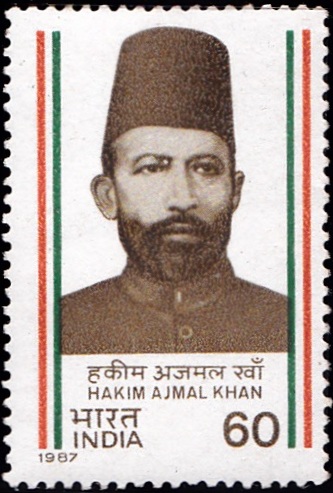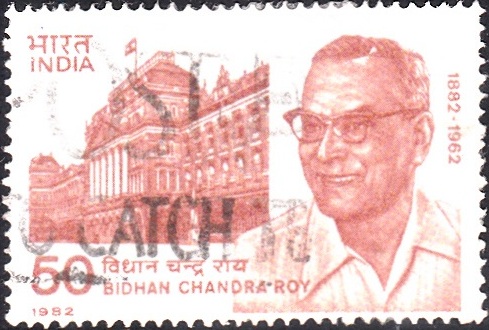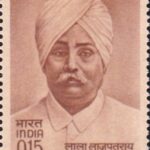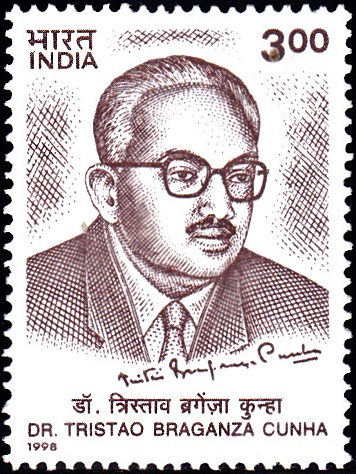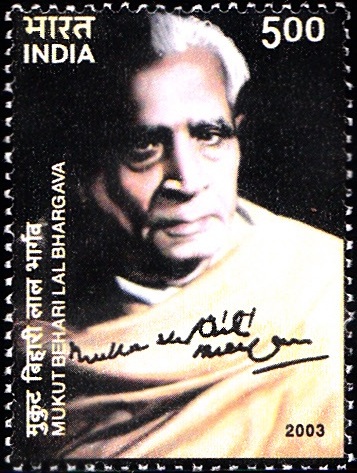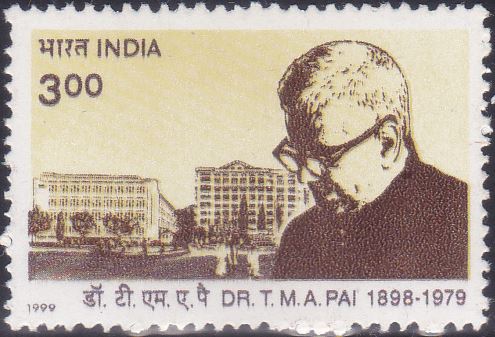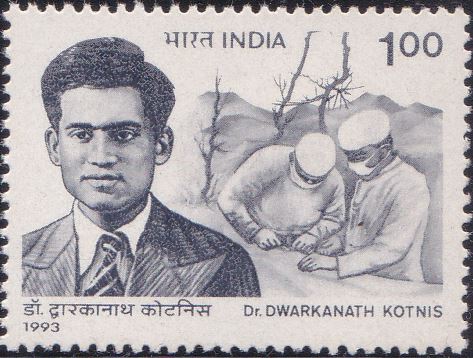
Dr. Dwarkanath Kotnis
A commemorative postage stamp on the 50th Death Anniversary of Ke Dihua, one of five Indian physicians dispatched to China to provide medical assistance during 2nd Sino-Japanese War, 1938 :
Issued on Dec 9, 1993
Issued for : The Department of Posts is happy to issue a special postage stamp on this illustrious son of India who proved to be a great humanist, internationalist and an anti-imperialist soldier and one who sacrificed his life for a human cause and brought honour to the country of his birth.
Type : Stamp, Mint Condition
Colour : Single Colour
Denomination : 100 Paise
Overall size : 3.91 x 2.90 cms.
Printing size : 3.55 x 2.54 cms.
Perforation : 13 x 13
Paper : Imported un W/M adhesive gravure coated stamp paper in sheets 50.8 x 53.5 cms.
Number of stamps Printed : 1 Million
Number per issue sheet : 35
Printing Process : Photogravure
Printer : India Security Press
Name : Dwarkanath Shantaram Kotnis
Born on Oct 10, 1910 at Solapur, Maharashtra, India
Died on Dec 9, 1942 at Kokun, China
About :
- Dr. Dwarkanath Kotnis was born on the 10th of October 1910 at Sholapur in Maharashtra in a lower middle class family. He entered the medical field and joined the G.S. Medical College, Bombay. Even in his student days he was inspired by the ideals of freedom and liberty and joined the movement against British rule. Because of this, he had to leave the college, but with single minded doggedness he graduated from the Grant Medical College, Bombay in 1936. This was a period of time in history when the spirit of anti-colonialism and anti-imperialism pervaded the atmosphere. It was also the period when Japanese aggression on China was in full flow. In response to the appeal for help from Chinese leaders, the Indian National Congress decided that medical teams would be sent and an ‘AID CHINA‘ Committee was formed. Many idealistic doctors empathised with this struggle and responded. Dr. Kotnis volunteered and became a part of the team of 5 doctors and left for China inspite of his family’s monetary needs. Even while on board the young Dr. Kotnis set to work and learnt the Chinese language from a Chinese scholar who was a co-passenger. Dr. Edgar Suai‘s book ‘RED STAR OVER CHINA‘ impressed Dr. Kotnis greatly, and he made up his mind to go to the areas where the Eighth Route army led by Mao Zedong was fighting against Japan.
- On reaching China the Mission began to work at various hospitals where wounded soldiers were admitted. While in China, Kotnis learnt the news of his father’s sudden death but decided to stay and serve the cause for which he went to China. The Mission reached Yenen in North China where they met Mao Zedong in March 1939. Dr. Kotnis and Dr. Basu continued to stay in China while the rest of the team returned to India. Dr. Kotnis was sent to Shansi–Chahar–Hoper border to work in the hospital set up by the famous Canadian Surgeon Dr. Norman Bethune. Dr. Kotnis became the Director of the International Peace hospital which was later named after Dr. Bethune. In an extremely difficult terrain in the remote hilly regions, he had to treat wounded soldiers and the local people.
- He also taught medicine to China‘s youth in the Junior Medical School of the Hospital and prepared many teaching notes in the Chinese language and thus built up the medical services in that difficult region. He identified himself with the struggling Chinese people in such a way that he even used to participate in cultivation and other social activities. Dr. Kotnis married Guo Qinglan a colleague-nurse in the hospital. She gave birth to a son who was named In–Hua meaning ‘India–China‘.
- Due to his rigorous work schedule, his health was breaking down. However, he did not think of his own health much and continued his routine work which resulted in his pre-mature death on 9 December 1942 at Kokun village of north China.
- In his condolence message Chairman Mao wrote “….. the army has lost a helping hand, the nation has lost a friend. Let us always bear in mind his international spirit“.
- In 1976 the Chinese Govt. set up a Dr. Kotnis Memorial Hall at Schizia–Chuang, Capital of Hopei province. Even non-Chinese school children are taught about Kotnis – how a foreign friend sacrificed his life for the liberation of Chinese people.
- Text Source : Dr. Kotnis Memorial Committee, Calcutta.



